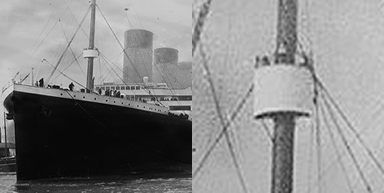Titanic Lookouts and Crow's Nest
Amongst the crew aboard Titanic were six Lookouts:
Frederick Fleet, Reginald Lee, Alfred Evans, George Hogg, George Symons, and Archie Jewell.
Stationed high up the ships mast in the crow’s nest, around 15 meters above the forecastle deck, it was the Lookouts job to constantly watch the sea to lookout for hazards to the navigation of the ship and for anything the officers on the bridge should be made aware of.

Titanic’s crow's nest
In pairs, Titanic’s lookouts worked shifts of 2 hours each in the crow’s nest, and then had 4 hours off, before having to go back on duty. During the day and at night, Alfred Evans and George Hogg were on duty between 12 – 2 and 6 to 8, Archie Jewell and George Symons were on duty between 2 to 4 and 8 to 10 and Frederick Fleet and Reginald Lee were on duty between 4 to 6 and 10 to 12.
The Crow’s nest, accessed by climbing up a ladder inside the mast, had a large bell, used to warn the bridge of dangerous ahead, and a telephone so that the officers on bridge could communicate with the lookouts in the crow’s nest.
Absent from the crow’s nest was a pair of binoculars. Although a pair was available as Titanic sailed between Belfast and Southampton, just before her maiden voyage; but when Titanic sailed from Southampton, the lookouts were without binoculars. To this day there have been many claims that this doomed Titanic; although, in reality, it’s unlikely that binoculars would have been of any use to the lookouts in spotting the iceberg that night.
On the night Titanic struck the iceberg, at about 9.30pm, 2nd Officer Charles Lightoller ordered 6th Officer James Moody to telephone the crow’s nest to tell them to keep a sharp lookout for ice, and to pass the message on when they left, which they did.
At 10pm Frederick Fleet and Reginald Lee took over from Archie Jewell and George Symons. In the freezing cold, Frederick Fleet stood on the port side of the crow’s nest while Reginald Lee stood on the starboard side. The watch was uneventful – until around 11.40pm, when suddenly they noticed the iceberg right in front of them; Frederick Fleet immediately rang the crow’s nest bell three times, then moved to the starboard side of the Crow’s nest, picked up the telephone to inform the officers on the bridge. 6th Officer Moody picked up the phone and asked what they had seen. “Iceberg right ahead” replied Frederick Fleet. “Thank you” replied James moody. There was no time, Titanic collided with the iceberg. Frederick Fleet and Reginald Lee remained in the crow’s nest until they were relieved at 12am by Alfred Evans and George Hogg.
All of Titanic’s Lookouts survived the disaster.
When the wreck of Titanic was discovered in 1985, the actual crow’s nest was still in place; within 3 years it had vanished from the mast. On the wreck today you can still see where it was as well as the access into the mast to climb down the ladder. The crow’s nest bell was recovered from the debris fields in 1987. In 2010-11 the bell was on display in London.
Related pages - Titanic Lifeboats, All Titanic Pages